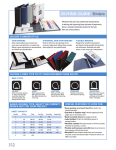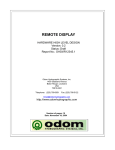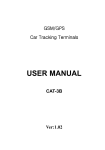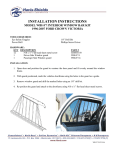Download User Manual - Quentin Sager Consulting
Transcript
Quentin Sager Consulting, Inc. [NALENND™ WIRELESS BLOCK IDENTIFIER – SOFTWARE USER’S GUIDE] NALENND™ data scrubber utility reference manual NALENND is a trademark of Quentin Sager Consulting, Inc. NALENND™ Wireless Block Identifier – Software User’s Guide 2 This document contains the specifications for the NALENND™ Wireless Block Identifier – Data Scrub Utility. These specifications are subject to change without notice. The data it describes is furnished under a license agreement, and may be used or copied only in accordance with the terms of the license agreement. NALENND™ Wireless Block Identifier – Data Scrub Utility Reference Manual Revised: August 20, 2011 Published by: Quentin Sager Consulting, Inc. 574 L E Byrd Road Patrick, SC 29584 Copyright © 2011 Quentin Sager Consulting, Inc. All rights reserved. No part of this publication may be reproduced in any form, in an electronic retrieval system or otherwise, without the prior written permission of Quentin Sager Consulting, Inc. Disclaimer and Limitation of Liability The information provided in this document is directed solely to users who have the appropriate degree of experience to understand and interpret its contents in accordance with generally accepted engineering, industry, or other professional standards and applicable regulations. NO REPRESENTATION OR WARRANTY IS MADE THAT THE INFORMATION IS TECHNICALLY ACCURATE OR SUFFICIENT OR CONFORMS TO ANY STATUTE, GOVERNMENTAL RULE OR REGULATION, AND FURTHER NO REPRESENTATION OR WARRANTY IS MADE OF MERCHANTABILITY OR FITNESS FOR ANY PARTICULAR PURPOSE OR AGAINST INFRINGEMENT OF INTELLECTUAL PROPERTY RIGHTS. QUENTIN SAGER CONSULTING SHALL NOT BE LIABLE, BEYOND THE AMOUNT OF ANY SUM RECEIVED IN PAYMENT BY QUENTIN SAGER CONSULTING FOR THIS DOCUMENT, WITH RESPECT TO ANY CLAIM, AND IN NO EVENT SHALL QUENTIN SAGER CONSULTING BE LIABLE FOR LOST PROFITS OR OTHER INCIDENTAL OR CONSEQUENTIAL DAMAGES. QUENTIN SAGER CONSULTING EXPRESSLY ADVISES THAT ANY AND ALL USE OF OR RELIANCE UPON THE INFORMATION PROVIDED IN THIS DOCUMENT IS AT THE RISK OF THE USER. NALENND™ North American Local Exchange NPA NXX Database 3 NALENND™ Wireless Block Identifier – Software User’s Guide Introduction The NALENND™ Wireless Block Identifier utility is a software application program used to process United States and Canadian ten digit telephone numbers. The utility can identify invalid and incomplete telephone numbers, current telephone exchanges and, identify whether a particular telephone exchange is wireless, pager, or landline at the 1,000 block level based on current North American carrier assignments. The NALENND™ utility cannot identify individual ported telephone numbers. Ported number identification requires the independently licensed Neustar Intermodal Ported Telephone Number database product. General Requirements The NALENND™ utility is a Win32 Console application and will execute under Windows XP, Windows Server 2003, Windows Server 2008, Windows Vista, or Windows 7. The utility requires approximately 58.6MB free disk space for the executable nalennd_wbi.exe and the associated data file nalennd_wbi.dat. To install the utility, the downloaded file nalennd_wbi.zip should be unzipped to a new or existing folder. Note the files nalennd_wbi.exe and nalennd_wbi.dat must always exist in the same folder for the utility to function correctly. Figure 1 Command Prompt Window NALENND™ North American Local Exchange NPA NXX Database NALENND™ Wireless Block Identifier – Software User’s Guide 4 General Operation The NALENND™ Wireless Block Identifier application is a basic data scrubber utility and requires you to specify the following information through command options and parameters. 1) 2) 3) 4) the name of the input file containing telephone numbers to be processed which column in the input file contains the telephone numbers to be processed what processing should be applied to the input file what to do with the results Input File You must supply the input file to be read. Virtually any file containing United States and/or Canadian telephone numbers can be processed. The utility expects the input file to be an ASCII text, comma-separated-value (CSV) or similar formatted data file with or without a header row. The utility can process an unlimited number of data rows, or records, and places no row or record limit on the input file. The only requirements for the input file are (1) it is ASCII text with each field or column separated by a single delimiting character (2) the maximum length for any line (including delimiters) cannot be greater than 4,092 characters and (3) the file has one unique column containing the telephone numbers to process. If a header row is present you should identify the column containing the telephone numbers by its label using the /C:label command line option. If the file does not contain a header row you must identify the column containing the telephone numbers by its zero based column number (counting left to right) using the /C:number command line option. Figure 2 Sample input file with header row NALENND™ North American Local Exchange NPA NXX Database 5 NALENND™ Wireless Block Identifier – Software User’s Guide Telephone Number Format There are no particular format requirements for the input telephone numbers. The utility can process any United States or Canadian telephone numbers in virtually any format. Example: +1 (555) 555-1234 1.555.555.1234 555 555-1234 (555) 555 1234 Output File The utility uses the input file to produce its output file without modifying the original data. Depending on the command line options, the input file is read, the telephone number type is identified and the original line is written to the output file with the telephone number type appended. Optionally the input file is read and only those records for a particular telephone number type (wireless, landline) are written to the output file. By default the utility writes the original line to the output file without modification (the single exception is appending the telephone number type when the /A command line option is used). This behavior can be changed to output the original telephone number only by using the /N command line option. Command Line Options Command line options are used to control the input, processing, and output of the utility. Each command line option must be preceded by either a single hyphen ‘-‘ or a single forward slash ‘/’ character with no space between it and the option. Multiple command line options must be separated by one or more space characters, when an option or its parameter contains a space character it should be enclosed using double quotation marks. The utility’s command line options may be specified in upper or lower case, option parameters are separated from the option with a single colon ‘:’ character. Option /I Parameter input filename Meaning Name of the file to be processed. /D delimiter Field delimiter used to separate field (column) values in the input source file. The default value used is a comma. If the source file uses a different value, such as a colon, semicolon, or similar value you will need to specify its literal value via this parameter. If the input file uses a tab or space character as its delimiter you must use the keyword TAB or SPACE to specify the value. /C label or| index If the input source file has a header row this parameter specifies the name or column label of the column containing the telephone number to check. If the input file does not have a header row this parameter specifies the zero based column number (counting left to right) of the column containing the telephone number to check. /N Output the telephone number only from the input record. If this option is not specified the default mode is to output the entire input record. NALENND™ North American Local Exchange NPA NXX Database NALENND™ Wireless Block Identifier – Software User’s Guide /A output filename 6 Output all records from the input file and append the telephone number type to each record. Output filename is optional, if not specified output is sent to the standard console. Appended line type values are: C – cellular/wireless P – pager L – landline . /L output filename Output all records with landline or fixed line telephone numbers from the input file. Output filename is optional, if not specified all output is written to the standard console. /W output filename Output all records with wireless (cellular, GSM, pager, etc.) telephone numbers from the input file. Output filename is optional, if not specified all output is written to the standard console. /S filename Specify a secondary output file where all records referring to invalid, obsolete, or disconnected telephone exchanges will be written. By default these records are discarded, this option provides a method to preserve these records for further investigation. /V Display the release date of the wireless block identifier data used by the application. NALENND™ North American Local Exchange NPA NXX Database 7 NALENND™ Wireless Block Identifier – Software User’s Guide Common Tasks and Examples Example: Remove all records containing wireless and pager telephone numbers from the input file named data.csv and write the original records containing landline telephone numbers to the output file landline.csv. The input file has a header row and is comma delimited, telephone numbers are stored in the column labeled “Telephone Number”. nalennd_wbi /i:data.csv /c:”Telephone Number” /l:landline.csv By default the utility writes all output to the console device (i.e. screen) therefore we can achieve the same result by not specifying the output file via a command line option and instead redirect or pipe the program output to the file landline.csv. nalennd_wbi /i:data.csv /c:”Telephone Number” /l > landline.csv Example: Scrub the input file named data.csv, append telephone number type to the original records and write the results to the output file phonedata.csv. Additionally write all records containing telephone numbers referring to disconnected telephone exchanges to the secondary output file disconnected.csv. The input file has a header row and is comma delimited, telephone numbers are stored in the column labeled “Telephone Number”. nalennd_wbi /i:data.csv /c:”Telephone Number” /a:phonedata.csv /s:disconnected.csv Example: Identify telephone number type for individual telephone numbers. When verifying individual telephone numbers the utility will discard all command line options except the immediate telephone number. nalennd_wbi 2012019999 Example: Extract all wireless and pager telephone numbers from the input file named data.csv writing just the telephone numbers to the output file wireless.csv. The input file has a header row and is comma delimited, telephone numbers are stored in the column labeled “Telephone Number”. nalennd_wbi /i:data.csv /c:”Telephone Number” /n /w:wireless.csv NALENND™ North American Local Exchange NPA NXX Database NALENND™ Wireless Block Identifier – Software User’s Guide 8 Error Reporting and Program Exit Code The utility reports errors through simple text messages and through the Program Exit Code. The program exit code can be tested programmatically through Windows® system API calls and by testing the batch file environment variable ERRORLEVEL. Result Code Description 0 The program successfully completed the operation. 1 An input filename was not specified. See the “/I” command line option. 2 The telephone number field/column in the input file was not specified. The input file cannot be processed unless the telephone number column is identified. See the “/C” command line option. 3 Could not open the NALENND™ wireless data block file nalennd_wbi.db. This file should be located in the same directory or folder as the nalennd_wbi.exe executable. 4 An internal SQL error occurred and the utility could not recover. 5 The input filename specified could not be opened. Verify the input file exists. 6 The specified telephone number field was not found in the input file. The most common reason for this error is the column label specified via the “/C” command line option has been misspelled or the zero based column number is invalid. 7 The output filename is the same as the input filename. NALENND™ North American Local Exchange NPA NXX Database

















